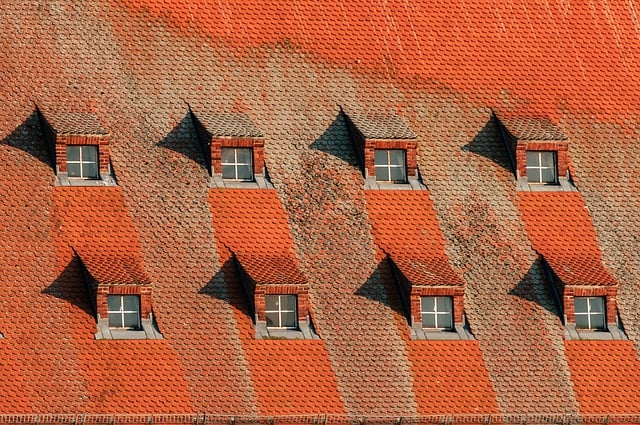Rust and corrosion, accelerated by moisture and elements, pose significant threats to gutter health, reducing lifespan if unaddressed. Regular inspections and cleaning are crucial for early detection of these issues, preventing structural damage and optimizing performance. Addressing signs like rust promptly through repair or replacement extends gutter life, saves costs, and ensures effective home protection from water damage. Key preventive measures include using rust-resistant paint, maintaining proper drainage, annual inspections, prompt debris removal, safe ladder use, and considering gutter guards.
Extending the lifespan of your gutters is crucial for maintaining a well-protected home. Rust and corrosion, however, can cause significant damage, leading to costly repairs or even replacement. This article delves into understanding these issues, their causes, and effects on gutters, offering practical advice on regular inspection, cleaning strategies, maintenance tips, and knowing when to replace them. Discover proven techniques for optimal gutter maintenance and prevent premature deterioration.
Understanding Rust and Corrosion: Causes and Effects on Gutters
Rust and corrosion are common enemies of gutters, capable of significantly reducing their lifespan if left unchecked. To understand why this happens, it’s essential to know that both are essentially the result of metal oxidation. Over time, moisture, humidity, and exposure to elements like salt or acidic compounds in the air can speed up this process.
In gutters, rust forms when iron-containing metals, commonly found in most gutter materials, react with oxygen and water. This reaction produces ferrous oxide, which weakens the metal’s structure. Corrosion, on the other hand, is a broader term that refers to any form of electrical or chemical deterioration of a material, often leading to structural damage and decreased performance. Regular gutter maintenance, including inspections and prompt cleaning, is crucial in preventing these issues by eliminating standing water, reducing moisture levels, and addressing any signs of oxidation early on.
Regular Inspection: Identifying Early Signs of Damage
Regular inspections are a crucial part of gutter maintenance, as they allow for early detection of potential issues. By keeping a close eye on your gutters, you can identify subtle signs of damage caused by rust and corrosion before they become significant problems. Look for any visible patches of rust on the gutter components, especially at connections and brackets. Corrosion often manifests as flaking or peeling metal, which could indicate weakened structural integrity.
Additionally, check for loose or missing fasteners, as these can be early indicators of wear and tear. During inspections, pay attention to any signs of water leakage or mold growth, as they might suggest underlying gutter damage. Promptly addressing these initial red flags will contribute to a longer-lasting gutter system and prevent more extensive (and costly) repairs down the line.
Cleaning Strategies: Removing Rust and Preventing Future Buildup
Keeping your gutters clean is an essential part of gutter maintenance, but it’s even more critical to address rust and corrosion to prevent future buildup. Rust can form when metal gutters come into contact with moisture and oxygen over time, leading to weakened structures that can no longer effectively channel water. To remove rust, start by gently scrubbing the affected areas with a soft-bristled brush or rag dampened with white vinegar. For more stubborn deposits, consider using specialized gutter cleaning solutions designed to dissolve rust without damaging the metal.
Once the rust is gone, implement preventive measures to stop future buildup. This includes regularly inspecting your gutters for any signs of damage or corrosion and promptly repairing them. Applying a coat of rust-resistant paint can also provide an extra layer of protection. Additionally, ensuring proper drainage by clearing debris and maintaining proper water flow will help keep moisture from pooling in your gutters, further reducing the risk of rust and corrosion.
Maintenance Tips for Long-Lasting Gutters
Regular gutter maintenance is key to extending the lifespan of your gutters and ensuring they perform optimally. Start by inspecting your gutters at least twice a year for any signs of damage, leaks, or blockages. Cleaning out debris like leaves, twigs, and acorns promptly prevents clogs that can lead to overflow and damage. Use a ladder safely and wear protective gear when accessing the gutters to avoid accidents.
Consider using gutter guards to prevent debris buildup, which not only saves time but also shields your gutters from rust and corrosion. Keep an eye out for any signs of rust or corrosion, as these can weaken the structure and lead to premature failure. Addressing these issues promptly through repair or replacement will save you money in the long run, ensuring your gutters continue to protect your home effectively.
When to Replace: Knowing the Limits of Repair and Maintenance
Gutters are an essential component of your home’s exterior, playing a crucial role in directing rainwater away from your foundation and preventing water damage. While regular gutter maintenance can significantly extend their lifespan, there comes a time when repairs may not be enough. Knowing when to replace your gutters is vital for maintaining the overall health of your property.
Signs that indicate replacement may include severe rust or corrosion, which often weakens the structural integrity of the gutters and makes them more susceptible to leaks. If you notice rust spots, especially near joints or brackets, it could be a warning sign. Additionally, if cleaning and maintenance no longer adequately address gutter issues, it might be time for a full replacement. Regular inspections will help identify these problems early on, ensuring your gutter system continues to function effectively and protect your home for years to come.
Rust and corrosion are common adversaries of gutters, but with proactive measures, homeowners can significantly extend their lifespan. By understanding the causes and effects, conducting regular inspections, employing effective cleaning strategies, and implementing maintenance tips, you can prevent premature replacement. Remember, timely intervention is key to maintaining optimal gutter health, ensuring water flows smoothly and protecting your home from potential damage. Embrace gutter maintenance as an essential part of your property care routine.
